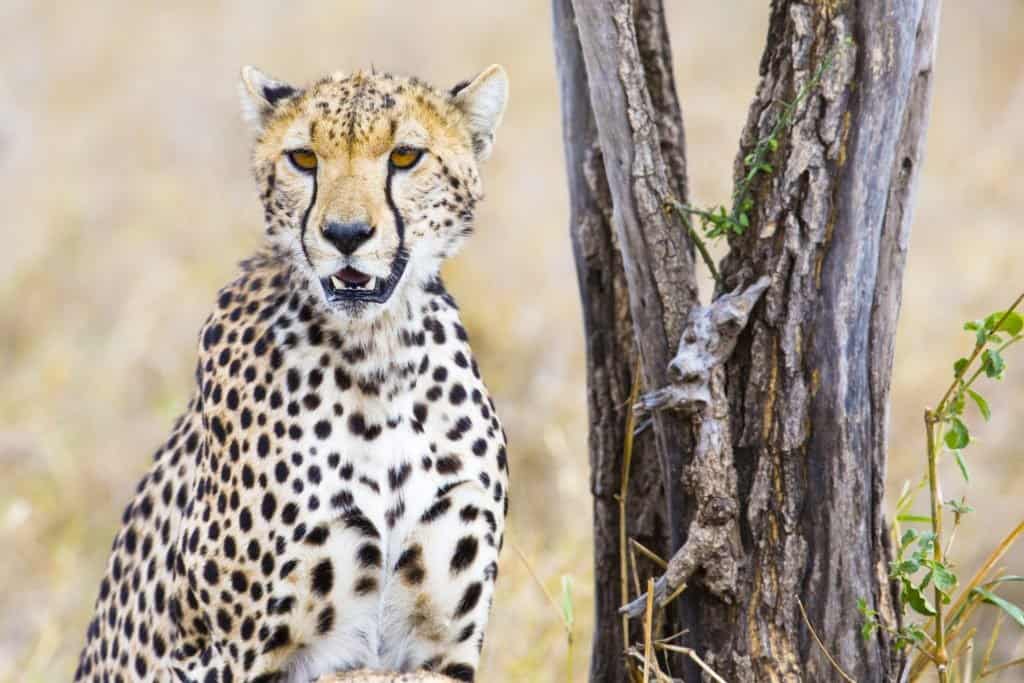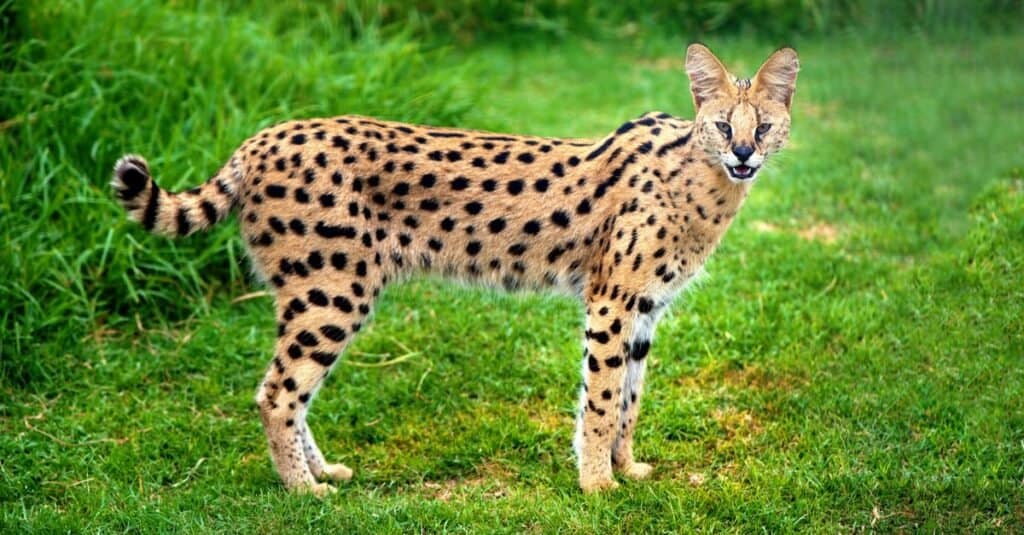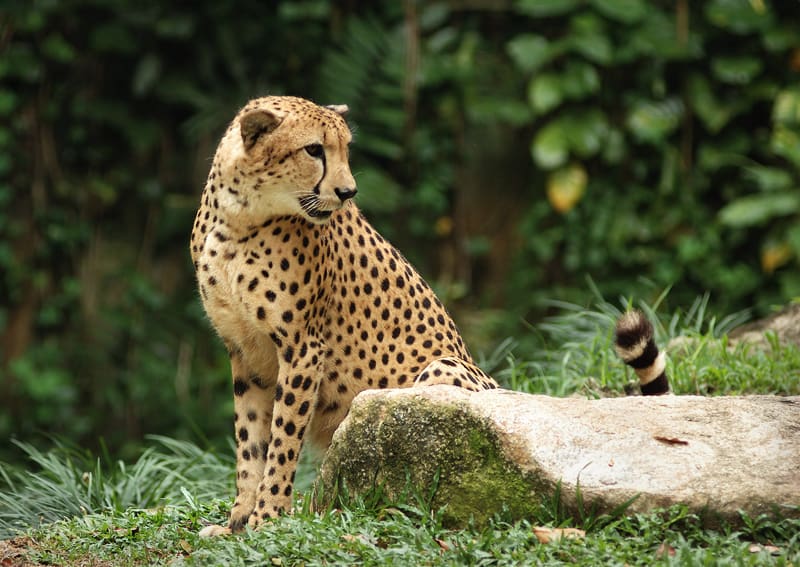Nothing is more confusing than staring at the serval and the cheetah simultaneously to make out the differences. To the average person, one of the cats looks like the mature version of the other. The similarities in their fur coats will leave you clueless. But in this article, we will show the differences between these closely related cats and reveal who is likely to win in a fight.
Comparing a Serval and a Cheetah

| Serval | Cheetah | |
|---|---|---|
| Family | Felidae | Felidae |
| Size | Length:23.6in – 39.4in Height:17in – 24in Weight: 7.7lbs – 41.9lbs | Length:43in – 59in Height:45in – 53in Weight:88lbs – 140lbs |
| Habitat | Native to Africa, found in grasslands, woodlands, and marshlands. | Found in Asia and Africa, in grasslands, shrublands, and deserts |
| Morphology | Small head, long ears, streamlined body, and long legs. Retractable claws and shorter tails compared to the cheetah. | Small head with a streamlined body, flexible spine, semi-retractable claws, long legs, and tail, longer tail than servals. |
| Diet | Carnivore: Rodents, birds, frogs, hares, flamingos, insects, and young antelope. | Carnivore: Gazelle, wildebeest, hare, springbok, steenbok, duikers, impala, gazelles, and juveniles of much larger animals like the warthog. |
The Key Differences Between Serval vs. Cheetah
While the serval and the cheetah might look indistinguishable because of their fur coloration, we can differentiate these cats through their size, morphology, and behavior. Moreover, both cats belong to the same Felidae family, which houses the caracal, golden cat, and savannah cat.
Let’s look in-depth at the differences between a serval and a cheetah.
Serval vs. Cheetah: Size

The cheetah is larger than a serval.
©Kjetil Kolbjornsrud/Shutterstock.com
One obvious difference between these two cats is their size. The serval measures between 23.6 inches to 39.4inches long, 17 inches to 24 inches tall and weighs 7.7 lbs to 41.9 lbs. Contrarily, the cheetah measures between 43 inches to 59inches in length, 45inches to 53inches in height, and weighs 88 lbs to 140 lbs. These parameters indicate that the cheetah is way larger than the serval; actually, the serval would look like a juvenile next to the cheetah. So the next time you seem to see a cheetah mom and her juvenile in a fight, look closer because it is most likely to be the serval and the cheetah at it again.
Serval vs. Cheetah: Appearance

Servals have bigger ears than those of cheetahs.
©Howard Klaaste/Shutterstock.com
Further differences between the serval and the cheetah are noticeable in appearance. While they have similar colorations of yellowish gold and dark spots that even misleads poachers, there are clear differences between the two cats in this regard. Both cats have similar coloration and small heads, making them look alike. However, the differences abound when you take a closer look. The serval has claws that can be fully retracted, while the cheetah has semi-retractable claws. Also, the cheetah has longer legs compared to the serval, and another major difference is in the size of their ears. The serval has rather big ears, while the cheetah has smaller ears.
Serval vs. Cheetah: Habitat
The two cats are native to Africa and share similar habitats. The serval can be found in grasslands, woodlands, and marshlands, while we can find the cheetah in grasslands, shrublands, and hot temperate deserts. These two cats share a habitat, which is enough to understand why people usually confuse them with one another.
Serval vs. Cheetah: Social Behavior

A cheetah in the Singapore Zoo
©PlasticTV, CC BY-SA 3.0, via Wikimedia Commons – License
Another area of differentiation between the two cats is their social behavior. Servals are known to be solitary and barely congregate in groups, although they may be seen resting in small groups during the day. Each serval has its territory and marks it out with scents and scratches. The male and female serval only meet to mate, after which each cat returns to its designated territory. The only sign of solidarity in this species is with the female serval and her cubs.
On the other hand, the cheetah can live in isolation but is known to exist in male groups called coalitions. These male cheetahs live together and are usually related by blood. They are litter mates that grow up together to keep a territory they live in and defend for the rest of their lives. They have a lot in common and hunt together. Sometimes, depending on the life span of all the cats, these coalitions can last around 12 years. When it comes to defending their territory, these blood brothers can fight to the death with another coalition to keep their space. The solitary male may never keep its territory as it would be unable to defend it against a coalition that could range between two and four males.
Although solitary males can join a coalition, they would not receive the same treatment as the blood brothers, who are known to stay close and even groom each other. If a coalition member is missing or lost, they make yip sounds that help reconnect the whole coalition back together. The only time a male cheetah leaves the coalition is to go after a female. The females do not particularly keep territory and are the only ones free to roam from one territory to another. Surprisingly, immediately after a male is done mating, it returns to its coalition.
Serval vs. Cheetah: Diet
Both cats are carnivores and hunt within their territories to feed. The serval feeds on animals like rodents, birds, frogs, hares, flamingos, and young antelope. On the other hand, the cheetah feeds on gazelles, wildebeests, hares, springbok, steenbok, duikers, impala, gazelles, and juveniles of much larger animals like the warthog.
Serval vs. Cheetah: Attack Methodology And Defense Mechanism
The attack and defense mechanisms of the two cats greatly differ. The serval depends on its ears, which are very sensitive to sound, to pick up the movements of potential prey before planning a pretty ambush for it. It waits patiently until its prey is in sight before pouncing on it and administering the killer bite. The serval is also known to leap high into the air to catch prey like birds. The cheetah, on the other hand, stalks its prey and gives it a great chase to catch and kill it.
Interestingly, it is the fastest land animal, and can reach up to 70mph when running after prey; this makes it practically impossible for most prey to escape the cheetah. The serval’s defense mechanism is to growl at grievances and arch its back to look more intimidating. When the above strategy does not work, the serval takes to running. The cheetah also exhibits similar defense traits as the serval. Unfortunately, its streamlined body, which gives it great speed, permits a very minute bite force, meaning that the cheetah cannot defend itself against bigger cats and has to take to flight instead of standing to fight.
Serval vs. Cheetah: Danger To Humans
Although both cats are wild, they are not considered active threats to humans; this is not a license to try playing with the next serval or cheetah you find.
Serval vs. Cheetah: Who Would Win in a Fight?
The cheetah is bigger than the serval and would win any fight that is likely to occur. However, there are few instances of a fight in the wild. The cheetahs are rather too gentle, and the temperament of the serval might aid it in putting up a confrontation and finding a chance to getaway.
The photo featured at the top of this post is © iStock.com/StuPorts
Thank you for reading! Have some feedback for us? Contact the AZ Animals editorial team.






